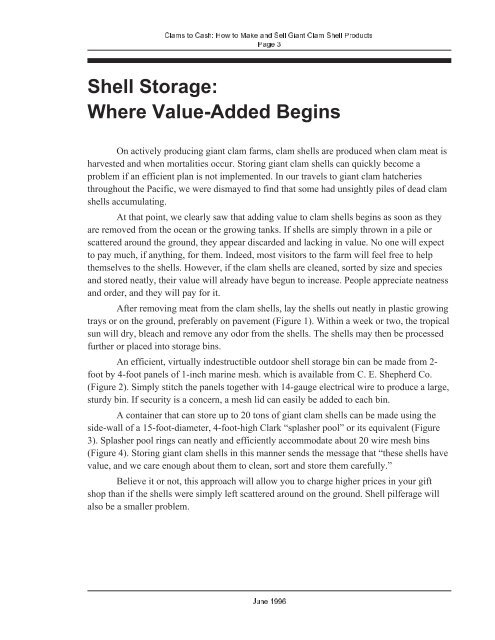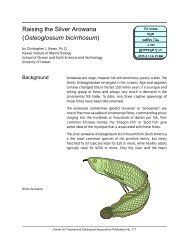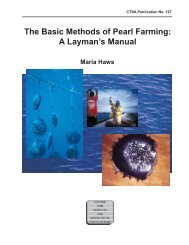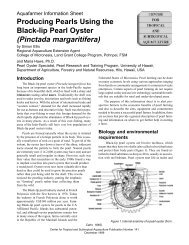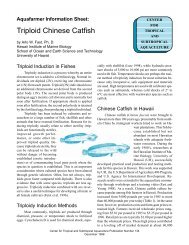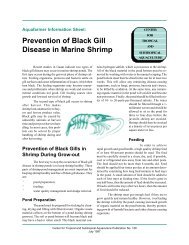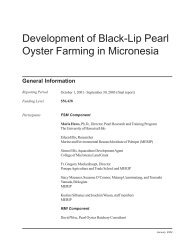Clams to Cash: How to Make and Sell Giant Clam Shell ... - eXtension
Clams to Cash: How to Make and Sell Giant Clam Shell ... - eXtension
Clams to Cash: How to Make and Sell Giant Clam Shell ... - eXtension
- No tags were found...
You also want an ePaper? Increase the reach of your titles
YUMPU automatically turns print PDFs into web optimized ePapers that Google loves.
<strong><strong>Clam</strong>s</strong> <strong>to</strong> <strong>Cash</strong>: <strong>How</strong> <strong>to</strong> <strong>Make</strong> <strong>and</strong> <strong>Sell</strong> <strong>Giant</strong> <strong>Clam</strong> <strong>Shell</strong> ProductsPage 3<strong>Shell</strong> S<strong>to</strong>rage:Where Value-Added BeginsOn actively producing giant clam farms, clam shells are produced when clam meat isharvested <strong>and</strong> when mortalities occur. S<strong>to</strong>ring giant clam shells can quickly become aproblem if an efficient plan is not implemented. In our travels <strong>to</strong> giant clam hatcheriesthroughout the Pacific, we were dismayed <strong>to</strong> find that some had unsightly piles of dead clamshells accumulating.At that point, we clearly saw that adding value <strong>to</strong> clam shells begins as soon as theyare removed from the ocean or the growing tanks. If shells are simply thrown in a pile orscattered around the ground, they appear discarded <strong>and</strong> lacking in value. No one will expect<strong>to</strong> pay much, if anything, for them. Indeed, most visi<strong>to</strong>rs <strong>to</strong> the farm will feel free <strong>to</strong> helpthemselves <strong>to</strong> the shells. <strong>How</strong>ever, if the clam shells are cleaned, sorted by size <strong>and</strong> species<strong>and</strong> s<strong>to</strong>red neatly, their value will already have begun <strong>to</strong> increase. People appreciate neatness<strong>and</strong> order, <strong>and</strong> they will pay for it.After removing meat from the clam shells, lay the shells out neatly in plastic growingtrays or on the ground, preferably on pavement (Figure 1). Within a week or two, the tropicalsun will dry, bleach <strong>and</strong> remove any odor from the shells. The shells may then be processedfurther or placed in<strong>to</strong> s<strong>to</strong>rage bins.An efficient, virtually indestructible outdoor shell s<strong>to</strong>rage bin can be made from 2-foot by 4-foot panels of 1-inch marine mesh. which is available from C. E. Shepherd Co.(Figure 2). Simply stitch the panels <strong>to</strong>gether with 14-gauge electrical wire <strong>to</strong> produce a large,sturdy bin. If security is a concern, a mesh lid can easily be added <strong>to</strong> each bin.A container that can s<strong>to</strong>re up <strong>to</strong> 20 <strong>to</strong>ns of giant clam shells can be made using theside-wall of a 15-foot-diameter, 4-foot-high Clark “splasher pool” or its equivalent (Figure3). Splasher pool rings can neatly <strong>and</strong> efficiently accommodate about 20 wire mesh bins(Figure 4). S<strong>to</strong>ring giant clam shells in this manner sends the message that “these shells havevalue, <strong>and</strong> we care enough about them <strong>to</strong> clean, sort <strong>and</strong> s<strong>to</strong>re them carefully.”Believe it or not, this approach will allow you <strong>to</strong> charge higher prices in your giftshop than if the shells were simply left scattered around on the ground. <strong>Shell</strong> pilferage willalso be a smaller problem.June 1996


